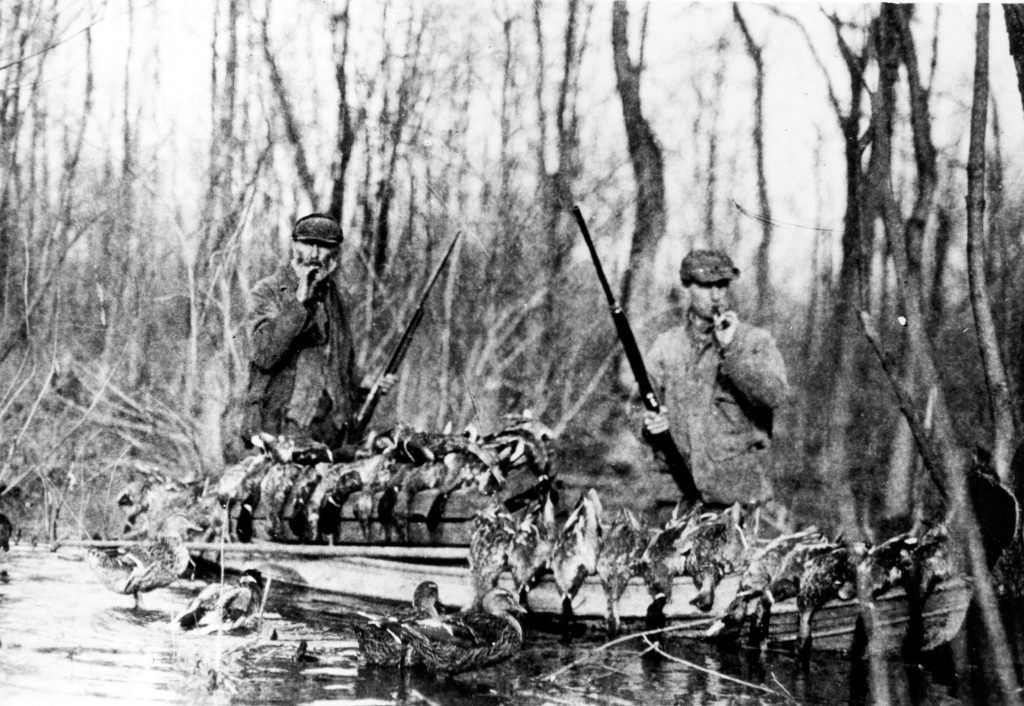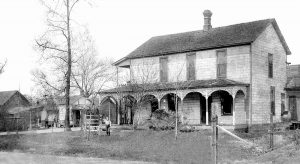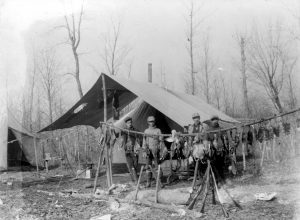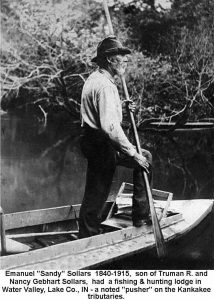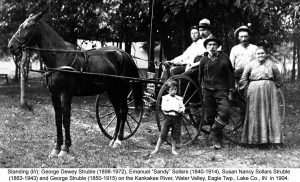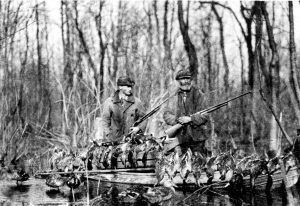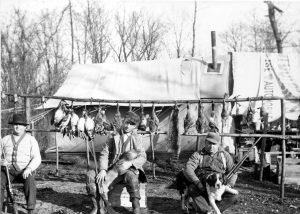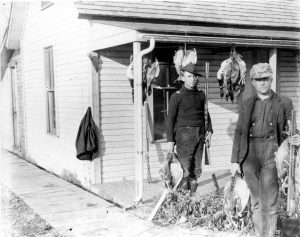Duck-Hunting Season at Hand and Sportsmen Prepare for Outing’s
Where Indianapolis Hunter Go to Shoot Ducks and the Outfit Necessary for the Trip…A Sport that Test the Powers of Endurance
The Sunday Journal
March 6, 1904
The duck hunting season is now “on” and the local sportsmen who enjoy this recreating are getting everything in readiness for the flight which take place at most any time. Duck hunting is one of the, things not carried on extensively around Indianapolis, except along White river, and when the ducks begin to fly hunters can be seen along the banks and out in boats. However the majority of local hunters go to Water Valley which is on the Kankakee river, where the sport can be enjoyed in the right way. This place is in the marsh region, which extends along the Kankakee river through Newton, White, Lake, Jasper, LaPorte and a number of northwestern counties. It is said by those who are in a position to know that there are many ducks this year and that the hunters will be numerous.
In these counties a number of the inhabitants are, professional hunters who kill ducks for the purpose of selling them; but no matter what the purpose of hunting them. it is an exceedingly rugged and healthy sport and one which requires a great amount of endurance, because there is much exposure about it. And one must be able to stand the sharp winds that blow at a stiff gale over the marsh lands and small lakes. It is a much colder sport than any other kind of hunting from the fact that there is little exercise about it, for a man is in a boat from the time he starts out in the morning until he returns in the evening. It is quite wonderful sometimes how the old duck hunters up around the marshes withstand as much exposure as they do, but they have become so accustomed to it that they seem all the better for the rough usage. When a man goes duck hunting, he must make tip his mind to be out early every morning and often it is long after dark before he gets back to the hotel.
Wild duck hunting up at Water Valley, it may be incidentally remarked. is not an expensive sport. as many people imagine, and those who conduct the boarding houses in the region do not endeavor to “graft,” as is often the case around such places. Hunters from Indianapolis and Chicago have found this out and are crowding to the place whenever the season is on.
Men who go up to the Kankakee season after season have made a special study of the duck and know pretty much every habit or peculiarity it has.
“The wild duck is not a bird that is peculiar to any locality.” said one of the local hunters, ”but can be found not only in the marsh lands of Indiana and the adjoining States, but also in many of the Southern States. especially those which have large marsh lands in them. The duck season in this State commences shortly after the first of September or late in November in fall and about March 1 in the spring. The flight of ducks depends entirely on the weather, and if very cold weather prevails in the North, especially if the water is frozen over. the birds will begin to go South in the, fall. and as soon as the ice breaks in the North in the spring they come back.
“The teal duck” said this gentleman, “is the most sensitive to cold, and is the first to make its appearance, and also the first too leave the lake regions. The mallard, which is considered a much better bird than the teal, because it is larger and its meat sweeter, can stand considerable cold weather. It is the last to leave the Northern marshes, remaining in this part of the country until late in the winter, and in the spring is the first to arrive. The mallard duck is built similar to the pintail duck in that both of these birds have long slender bodies. The canvas back is the popular bird for eating purposes, because its meat is the finest of any of the species, but on account of its scarcity this is seldom found, and when one is shot it is considered quite a prize. Another peculiar bird is known as the “rubber-neck,” because of the extreme length of its neck. The wild geese fly about the same time as the ducks, and the only difference in their flights is that the geese go North earlier in the spring.”
THE HUNTER’S OUTFIT
Since the hunting of ducks has become such a general sport man who hunt them merely for business are learning that it is a rather difficult matter to find places which are not overrun by hunters from the cities. Those who hunt ducks for pleasure have found that warmth and dryness are the most essential things in providing for the outing, and that they must wear plenty of good woolen clothing, for it is an extremely hard and uncertain sport. The first necessity in the garb of a hunter is plenty of heavy underwear. He should also wear thick trousers over which is drawn a pair of dead-grass canvas overalls. A heavy blue flannel shirt or sweater is necessary in protecting the chest, as is likewise a high-cut vest, preferably without sleeves. Over these can be worn an ordinary canvas or corduroy coat. A regular hunting coat is not necessary, because game and shell pockets are not used. After a hunter’s body is well clothed his feet should be the next looked after because in this kind of hunting he is wading in the deep marshes frequently through all day and must be certain to keep his feet warm or he will suffer great inconvenience. To do this a pair of rubber boots reaching to the hips and about three sizes too large is necessary. The reason the boots are worn so much larger than the feet is to enable the wearer to put on two pairs of heavy woolen socks together with a pair of moccasins. A cap with a hood attached and a pair of warm gloves complete the outfit. A very useful garment in case of rain or snow is a yellow rubber coat, or, as it is technically called, a “slicker.” This coat is also very convenient to wear when the wind is blowing. as the breeze cannot penetrate it.
Each duck hunter has his favorite make of gun and it would be impossible to get him to use another. The professional duck hunters use the guns that they have had for years, and none of the new styled hammerless. shell-ejector guns “go” with them. They look upon such arrangements as entirely for the novice. The gun that should be use, however, must be full choke and very close shooting. In duck hunting it is not required that the shot should spread as in other kinds of shooting. The gun should be of short stock so that it will not become easily entangled in the hunter’s clothes, and should be heavy, weighing from eight to nine pounds so as to stand the recoil of the heavy charges used. The gun must be constructed in a simple manner so as to stand all kinds of weather and of a make that does not easily get out of order. The shells that are used should be loaded with one ounce or one and one-eighth ounces of 4 or 5 shot, the latter preferred. What one must be certain of is to have plenty of powder in the, shells, for the shot have to be carried a long way and there has to be a great amount of force behind them. The shells should be kept in a waterproof tin box put in the front part of the boat and not exposed to the weather.
Of course hunting ducks is all done in boats. The man who goes to the marshes for the purpose of hunting merely for sport has to hire a man with a boat to row him about. These men know where the ducks are the most plentiful and they also act as guides. These “pushers,” as they are called, are peculiar fellows and are generally old professional hunters. They are not overly fond of the sportsmen from the city, for they have reached the conclusion that there are few men from town who can shoot ducks. When one of these boatmen really finds a man who knows how to shoot he takes a liking to him and the hunter will find that his sport will be greatly improved.
POPULAR SANDY SOLLARS
The chief of the boatmen is Sandy Sollars, who lives at Water Valley. He knows the marshes and river as few people do, for he has been there for a great number of years. He is a man over sixty years old, but has none of the infirmity which age brings. Sandy is a character in every sense of the word, and knows the habits of ducks and cannot he fooled when it comes to finding them. When a hunter can get Sandy Sollars to push a boat for him he thinks himself very fortunate. Sandy has a little farm where he raises vegetables and during the summer months he fishes extensively. Pickerel is the favorite fish around this place and is found in great abundance. In the winter Sollars hunts and tops mink. muskrat and coons. His coon dog is one of the most noted in that part of the country and can tree a coon during the day, which is considered quite a feat. Another sport which Sandy likes exceedingly well is hunting bee trees. He is quite an expert at this and always has a large quantity of honey about the house. Whenever he sees a honey bee he can follow it through woods, and there is no getting away for the bee, for Sollars will follow it until it goes home and then he will spot the tree.
Sandy Sollars is quaint and full of droll humor. He is original in his expressions, and as he has always hunted and fished, a volume entitled the “Adventures of Sandy Sollars” could be very easily written. Nothing ever disconcerts or excites him. One day last fall he was pushing a boat for Dr. Craig, an Indianapolis duck hunter. As they went under the railroad bridge which crosses the Kankakee river the rear of the boat struck one of the piers and Sandy was thrown out in about teen feet of water. He came up blowing the water out of his mouth. and clambering into the boat said in his droll way: “I always lowed I’d be Baptist and here I get soused and ther ain’t no preacher to do the “speakin.” He got in the boat and without changing clothes went on hunting and without no discomfort from it.
Experts say that to go duck hunting the start should be made early in the morning and the boat should be taken to where the ducks are flying. The hunter then observes carefully where the birds are staying, which is generally in what is called a “flyway.” The sportsman selects one of those and takes his stand in a place where there will be sufficient cover to form a blind. The stand must also be close to open water, so that the decoy, can be set. The decoy ducks are of mood, rubber or canvas and held in place by weights which are inflatable. The decoys are set so that they will have the appearance of a flock feeding. After these are set the boat is got into a bunch of cane or flags for concealment. The hunter must get out and cut cane and put it around the boat so that any part of it which the standing cane does not conceal cannot be seen. There is quite a trick in building these blinds, for they must not be made too bulky or dark. They must have a natural appearance, for there is no bird as observing as the duck, and the least thing out of the ordinary will frighten him. On this account everything of color or which is the least bright must be got rid of.
LYING IN WAIT
After this is completed the hunter must lie down in the bottom of the boat and wait. When the ducks begin to come a caller is used whistle that makes a sound similar to the quack of a hen mallard. The birds then begin to hover over the decoys, and it is the hunter’s opportunity to shoot. He should not be in a hurry to do this, for it is in quick shooting that the majority of shots are missed. He should not shoot recklessly and aim at the flock, but he should mark one certain bird and aim to kill it. The average, hunter makes a mistake in trying to make what is called doubles—that is, to make two shots in succession into a single flock. When the birds are flying instead of hovering over the decoys the hunter should get down in the boat and if he can’t get a good shot he had better wait until they come over again. It may be said that one can hardly shoot too far ahead of these flying birds, for they go with such velocity that if the aim is not taken considerably in the lead of them the whole flock will he missed.
After the birds are killed the man has to retrieve them himself, unless he has a water spaniel. Many hunters prefer, however, not to take dogs with them, on account of the little space the boat affords, and many think that it is very cruel to make the dogs swim through ice-cold water to get the bird and then lie in the boat until the next shot, all wet and covered with icicles. The dead birds have twigs stuck In their necks and are put out as decoys. The dead ducks make better decoys than the artificial ones. Ducks go to roost late: in fact. they select their resting place for the night after sundown. and should not be shot into after this. Shooting at the birds when they are roosting only drive them out of the locality much sooner, and is a very unsportsmanlike practice. The birds are in their feeding grounds all day long, and it is there they should be hunted.
Another method of hunting these birds is to use sink tubs, and this method is becoming very popular among hunters. The sink tubs are made of galvanized iron and are constructed according to the size of the man. The hunter takes his tub into the marsh or flyway and sinks it level. After this it is staked down and the water is baled out. The man then gets in, sending his boat back to the shore, and crouches down with his head hardly above the level, and in this position he often waits for hours for the game. It takes an expert to hunt ducks because of the rate of speed at which they fly. The slowest-moving duck goes at forty or fifty miles an hour. These are the mallards, and they are the easiest of all birds to shoot. The pintail is a fast flyer. but the fastest of them is the bluebill. Which goes a the rate of 120 miles an hour and is an extremely hard bird to shoot.
Among the hunters who will leave next week are Edward Stiegelmeyer, a member or the fire department, and George Van Sant. They are going to make a trip down White river and expect to be gone about nine days. Stiegelmeyer built his own boat, which is a large. comfortable affair. The manner in which the two men expect to hunt is to float down the river during the day, and at night camp along the bank. Both men have been making great preparation, and am expecting a good time. They have an oil stove which can be used for heating purposes and also for cooking. Stiegelmeyer friends predict that the destruction to the ducks will be enormous, and if he brings back a duck to every man who has left his order with him, he will have to charter a freight train. By the amount of provisions, he is taking with him his follow firemen say that they think he is going on a cruise to be gone for several years. They claim that he is thinking about putting his boat in the Japanese navy as a warship. Stiegelmeyer takes all of their “kiddings” in good part, however, for he is deeply occupied thinking about the pleasure he is going to have on his trip.
Among other local men who are great ducking enthusiasts are Joseph R. Morgan, who was representative in the last Legislature; Charles Forbes, Dr. Hodgkin, Frank Churchman, Harry Stout, Capt. Harry S. New. Dr. L. C. Cline, Dr. W. B. Craig, John Stroble and John Gasper.


